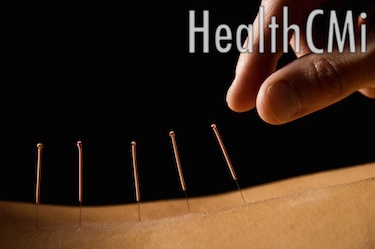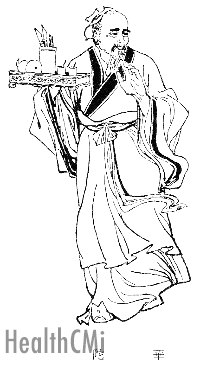Acupuncture reduces lower back pain and disc degeneration. A new study demonstrates that electroacupuncture applied to specific acupuncture points on the back stimulates beneficial biochemical bodily responses that benefit the spine. Researchers successfully measured scientifically repeatable chemical responses to acupuncture that suppress intervertebral disc degeneration. 
The controlled acupuncture continuing education study compared true acupuncture with sham acupuncture to ensure that placebo responses to treatment were eliminated as variables. The laboratory experiment examined the effects of electroacupuncture at Jiaji (EX-B 2) points on the axially compressed lumbar discs of L4 and L5. Acupuncture was applied for a total of 20 minutes, once per day, for a total of 28 days. Electroacupuncture was administered at 2 - 15 Hz at 1 -2 mA bilaterally.
Compression of the lumbar discs induces pain, inflammation and disc degeneration. Two important chemical processes are involved in the body’s response to compression. Pain and degeneration of the spine are created, in part, by an inflammatory cascade of two proteins in the lumbar discs: increased matrix metalloproteinase-13 (MMP-13), decreased tissue inhibitor of metalloproteinase-1 (TIMP-1) proteins. The sham acupuncture group did not influence protein expression. However, the true Jiaji (Huatoujiaji) acupuncture group successfully reduced MMP-13 and upregulated TIMP-1 levels. The changes were clinically significant and the researchers note that increases in TIMP-1 are “remarkably higher” when electroacupuncture is applied.
Biochemicals
MMP-13 is involved in healthy embryonic development but is also involved in human carcinoma, rheumatoid arthritis and osteoarthritis development. Acupuncture successfully downregulated abnormally high levels of MMP-13 caused by disc compression. TIMP-1 is a natural inhibitor of MMPs including MMP-13. TIMP-1 also promotes cellular proliferation and has anti-apoptotic functions. Acupuncture successfully upregulated TIMP-1 that had been suppressed by disc compression.
Acupuncture
Jiaji acupuncture points are located approximately 0.5 - 1.0 cun lateral to the depressions below the spinous processes of the vertebrae. They run along either side of the spine. According to Traditional Chinese Medicine (TCM) theory, Jiaji points regulate internal organs and benefit the spine.  Master Hua Tou
Master Hua Tou
Jiaji points have been used by acupuncturists for the treatment of pain and stiffness of the back for over 1,000 years. The discovery of the Jiaji points are attributed to the Han Dynasty physician Hua Tou (c. 140 - 208). As a result, the points are often called Huatoujiaji acupuncture points. Hua Tou is also credited with developing anesthesia for surgical procedures, advancing herbal medicine, developing TCM theory and for monumental advances in acupuncture and moxibustion. Now, modern research confirms a relationship between positive patient outcomes and biochemical responses induced by acupuncture needling of Jiaji points. Hua Tou is back in the news and his contributions continue to impact modern medicine.
Agreement
In related research, acupuncture is found highly effective for the treatment of chronic low back pain. Researchers at Dongzhimen Hospital conclude that acupuncture effectively decreases patient pain levels and reduces days missed from work due to low back pain in a randomized, controlled investigation. In yet another study of 236 patients that was published in the Journal of Musculoskeletal Pain, researchers conclude that acupuncture is effective for the treatment of low back pain. A total of fourteen acupuncture treatments were administered over four weeks in this randomized, controlled investigation. The researchers note that acupuncture has “beneficial and persistent effectiveness against CLBP (chronic lower back pain).”
The Jiaji study investigates local acupuncture. By contrast, many studies have also measured the effects of distal acupuncture on lower back pain. A single acupuncture point, LI4 (Hegu), was chosen as the focus of a distal acupuncture investigation. A group of 187 patients with chronic lower back pain received eighteen treatments at LI4 over seven weeks in this controlled clinical investigation. The participants had clinically significant reductions in lower back pain.
This article is a short list of acupuncture continuing education investigations demonstrating that acupuncture reduces lower back pain. In many ways, pain reduction put acupuncture on the medical map in the USA. Subjective reports of acupuncture’s ability to reduce pain have contributed to its popularity. Full time acupuncturists are found on the staff of professional baseball, basketball and football teams to assist in pain reduction and to enhance sports performance. Now, modern research supports the subjective reports of pain reduction with objective findings demonstrating acupuncture’s ability to stimulate healing within the body.
References:
Zou, J., G. F. Huang, Q. Zhang, Y. Gao, and B. Y. Wang. "[Effects of electroacupuncture stimulation of" Jiaji"(EX-B 2) on expression of matrix metalloproteinase-13 and tissue inhibitor of metalloproteinase-1 in intervertebral disc tissue in rabbits with lumbar intervertebral disc degeneration]." Zhen ci yan jiu= Acupuncture research/[Zhongguo yi xue ke xue yuan Yi xue qing bao yan jiu suo bian ji] 39, no. 3 (2014): 192-197.
Bahrami-Taghanaki, H., Y. Liu, H. Azizi, A. Khorsand, H. Esmaily, A. Bahrami, and Zhao B. Xiao. "A randomized, controlled trial of acupuncture for chronic low-back pain." Alternative therapies in health and medicine 20, no. 3 (2014): 13.
Mingdong, Yun. Na, Xiong. Mingyang, Guo. Jun, Zhang. Defang, Liu. Yong, Luo. Lingling, Guo. Jiao, Yan. Acupuncture at the Back-Pain-Acupoints for Chronic Low Back Pain of Peacekeepers in Lebanon: A Randomized Controlled Trial. Journal of Musculoskeletal Pain. P 107-115, V 20.
Hegu Acupuncture for Chronic Low-Back Pain: A Randomized Controlled Trial. Mingdong Yun, Yongcong Shao, Yan Zhang, Sheng He, Na Xiong, Jun Zhang, Mingyang Guo, Defang Liu, Yong Luo, Lingling Guo, and Jiao Yan. The Journal of Alternative and Complementary Medicine. February 2012, 18(2): 130-136. doi:10.1089/acm.2010.0779.


